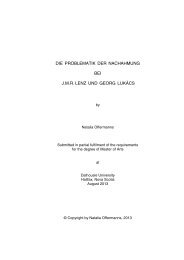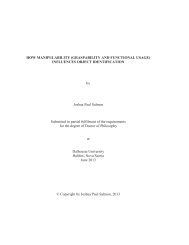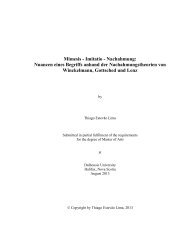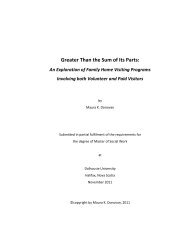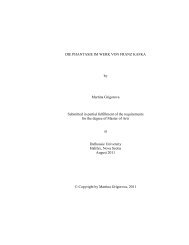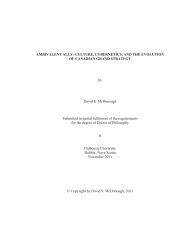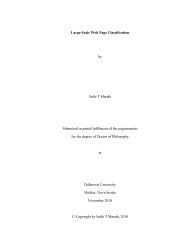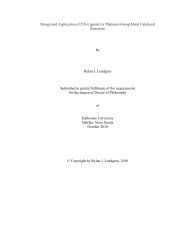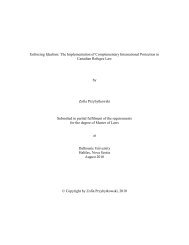ADAPTING TRISTRAM SHANDY by Adria Young Submitted in ...
ADAPTING TRISTRAM SHANDY by Adria Young Submitted in ...
ADAPTING TRISTRAM SHANDY by Adria Young Submitted in ...
You also want an ePaper? Increase the reach of your titles
YUMPU automatically turns print PDFs into web optimized ePapers that Google loves.
medium and its conventions can be considered. And this is an important element to<br />
consider <strong>in</strong> the exploration of a Shandean adaptation, s<strong>in</strong>ce Sterne’s text is aware and<br />
<strong>in</strong>terested <strong>in</strong> the actual medium with<strong>in</strong> which it appears. Bolter and Grus<strong>in</strong> use the term<br />
“hypermedia,” which branches off from their concept of remediation, to label media that<br />
is hyperaware and self-referential (Bolter and Grus<strong>in</strong> 53). Hypermedia make “constant<br />
references to other media and their contents” (Bolter and Grus<strong>in</strong> 54) with<strong>in</strong> the particular<br />
remediation, s<strong>in</strong>ce all media is a convergence of other, earlier media; the power of<br />
hypermedia is <strong>in</strong> its attention to its medial properties, which provides an “authentic”<br />
experience for the viewer (Bolter and Grus<strong>in</strong> 53). 80 That is, hypermedia self-references as<br />
media and identifies all the other media properties with<strong>in</strong> the remediation, as <strong>in</strong>, “Hey,<br />
look at me! I’m an adaptation movie based on a book!” This is because, Bolter and<br />
Grus<strong>in</strong> argue, no medium “function[s] <strong>in</strong>dependently” (Bolter and Grus<strong>in</strong> 55). S<strong>in</strong>ce<br />
remediation necessarily adds to the properties of the orig<strong>in</strong>al text, what results is an art<br />
object that re-presents the mean<strong>in</strong>g and themes of the text <strong>in</strong> a new way. This renders the<br />
fidelity approach <strong>in</strong>sufficient and irrelevant. If, however, fidelity is re-understood to<br />
capture the spirit of the text, the <strong>in</strong>termedial aspects of the adaptation become remarkable<br />
and <strong>in</strong>cluded.<br />
The recognition of <strong>in</strong>termediality works well with Hutcheon’s theory of<br />
adaptation as an <strong>in</strong>terpretive and creative process (and thus product) because adaptation<br />
necessarily <strong>in</strong>corporates and mediates different media forms, beg<strong>in</strong>n<strong>in</strong>g with the text. 81<br />
There are choices made <strong>in</strong> the production of a film about how to <strong>in</strong>corporate the various<br />
forms of media with<strong>in</strong> the film adaptation. The “heritage film,” for <strong>in</strong>stance, privileges<br />
the text-to-screen transfer (should there be <strong>in</strong>ternal monologue or voice-over?) rather than<br />
64



